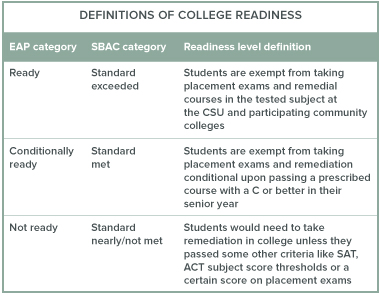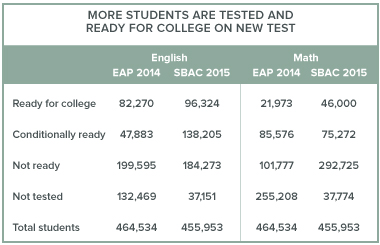Last week, California released the results of the new statewide tests aligned with the Common Core State Standards for students in grades 3-8 and grade 11. The 11th-grade test—from the Smarter Balanced Assessment Consortium (SBAC)—is designed to measure whether students are on track to be ready for college and careers after graduation. In fact, the CSU and community colleges can use scores from the test to determine if students are ready for college level courses. The results show that about half of 11th-grade students are at least conditionally ready for college level courses in English and less than a third are ready for college level math courses.
 The fact that most 11th-grade students are not yet ready for college is not necessarily news for California. Since 2004, California students have been able to participate in California’s Early Assessment Program (EAP), which used an optional statewide test to determine college readiness levels of 11th-grade students. The college readiness identification component of the new tests is based on the EAP and informs 11th grade students whether they are ready, conditionally ready, or not ready for college.
The fact that most 11th-grade students are not yet ready for college is not necessarily news for California. Since 2004, California students have been able to participate in California’s Early Assessment Program (EAP), which used an optional statewide test to determine college readiness levels of 11th-grade students. The college readiness identification component of the new tests is based on the EAP and informs 11th grade students whether they are ready, conditionally ready, or not ready for college.
We cannot directly compare the test results to see if students have improved, as the EAP was optional for all students and the math section was only offered to students in advanced math courses, meaning a large portion of students were untested by the EAP. But the two tests are similar in that they show that a majority of high school juniors are likely not ready for college in both English and math. The new test data does show that a large majority of students are now tested in English and math, meaning more students now know whether they are ready for college level work.
 But there is also some good news here for California. For students, new ratings regarding college readiness come early enough for the information to help before they enroll in their 12th-grade classes. Prior research on the EAP suggests that the optional testing helped lower the likelihood that a student would need remediation. Now, because the SBAC test is mandatory, almost all students in California will know whether they are ready for college or need to make improvements during their senior year.
But there is also some good news here for California. For students, new ratings regarding college readiness come early enough for the information to help before they enroll in their 12th-grade classes. Prior research on the EAP suggests that the optional testing helped lower the likelihood that a student would need remediation. Now, because the SBAC test is mandatory, almost all students in California will know whether they are ready for college or need to make improvements during their senior year.
This year, over 90,000 more students than last year were given a rating of “conditionally ready” in English. This will give them an opportunity to avoid remediation in college, by taking a prescribed 12th-grade English class and receiving at least a C grade.
And while it might seem that informing almost 200,000 more math students that they are not ready for college would be discouraging, prior research on the EAP suggests that a “not-ready” rating did not discourage students from enrolling at a CSU. Finally, the SBAC can serve as one of multiple ways for students to demonstrate college readiness. Research suggests that using multiple measures—rather than relying solely on a placement exam—can keep students from being misdirected into remediation.
For the state, the new test provides a benchmark by which to measure future progress and a way to compare across states. Of the eight states that have released test scores, California is 4th and 5th in the proportion of students who are at least conditionally ready for English and math, respectively. As more states release their scores, California will have a clearer picture of how well it is preparing high school students for college on a national scale.


